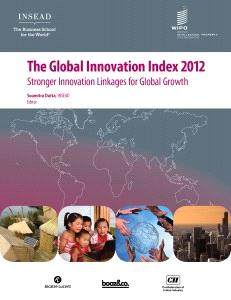Innovation is nowadays a fancy word, present almost in every industry but more specifically in ICT industry as it is at the core of the business. However, it is difficult sometimes to have clear data and analysis of what innovation is and what are the best public policies to foster innovation. Everybody tries to find the right compass to guide its future path and reach the virtuous circle of growth.
Just precisely, the INSEAD in cooperation with WIPO (the World Intellectual Property Organization) and key “knowledge partners” such as Alcatel-Lucent, the global consulting firm Booz & Company, the Confederation of Indian Industry and an advisory board of experts, has recently published an amazing report: its 5th Global Innovation Index 2012, the also known as the GII 2012.
The Global innovation index ranks more than 140 countries on the basis of their innovation capabilities and their ability to make use of their innovations, measuring 84 different criteria. The GII is calculated as the average of two complete sub-indexes.
One concerns the innovation capacity existing in a country covering institutions (including the political and regulatory environment, but also the business environment), human capital and research (including education, tertiary education and R&D), infrastructure (general infrastructure, ICTs and this year also ecological sustainability), market sophistication (including credit, investment and trade & competition), and finally business sophistication(knowledge workers, innovation linkage and knowledge absorption).
The second sub-index deals with the outcomes of innovation and analyzes knowledge and technology outputs (knowledge creation, impact and diffusion), but also creative outputs (intangibles, goods and services and this year also including the online creativity).
This year Switzerland, Sweden and Singapore are the leaders of this ranking (as last year´s ranking), followed by Finland, UK, the Netherlands, Denmark, Hong Kong, Ireland and the USA.
The leaders by regions are:
- Switzerland in Europe,
- the US in Northern America,
- Singapore in South East Asia and Oceania,
- Israel in Northern Africa and Western Asia,
- Chile in Latin America and the Caribbean,
- India in Central and Southern Asia,
- Mauritius in Sub-Saharan Africa.
The report is divided in 11 chapters with interesting data concerning the evolution of the index and the reasons of the changes in Chapter 1, the role of public-private partnership in innovation process, some case analysis from chapters 2 to 7, but also some reflections on policy issues (chapters 8 to 11), highlighting the key role of Internet and the content creation.
The main outcomes of this publication are that innovation is key to get out from the current economic crisis and that effort to support and foster innovation is essential to reach a sustainable growth. The high-income economies are better ranked concerning innovation but there are some changes appearing on middle and lower income economies, citing also China or India as active countries dealing with innovation, even if more efforts are needed concerning the outcomes.
This is an interesting publication which brings a complete perspective on this matter, having a wide range analysis of metrics and policies thoughts, on a key element for the future: to bet for innovation and to create the adequate eco-system to take the utmost advantage of the innovation process.
If you wish to see the detailed results and analysis, have a look at the full report here.
Concerning Telefónica, we already presented through several posts in this Blog our strong compromise with innovation, so we carefully follow this relevant issue and we share the idea that innovation is essential for future growth.
Just this week, Carlos Domingo, CEO of Telefónica R&D and Director of Product Development and Innovation in Telefónica Digital, has been invited by the Spanish Senate, more specifically by the Commission of Economy and Competitivity, to expose some proposals to improve R&D and Innovation (R&D+i) policies. He focused its intervention on the opportunity offered by ICTs to get out from the economic crisis and to assure a sustainable growth.
However, to make this happen, he explained that we need to adapt our public policies and foster the creation of innovative ICT businesses, making R&D investments more efficient and ensure the technological transfer. Innovation is more than a simple invention, it is invention, of course, but also monetizing and we need to support both areas.
Telefónica´s compromise with innovation is clear and currently the group is leading several initiatives in that sense: Wayra as a way to support the creation of new ICT innovative businesses, venture capital funds such as Amérigo or the INNVIERTE Programme in Spain and the strong boost given to patent generation and recruitment of talent, especially for software developers. Telefónica invested in 2011 8% of its total incomes in R&D and Innovation and will continue to do so. This is the compass that guides us up to now!











